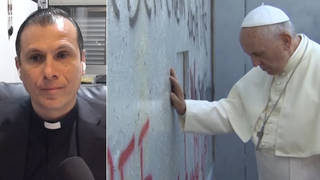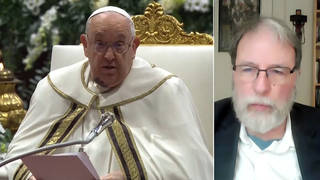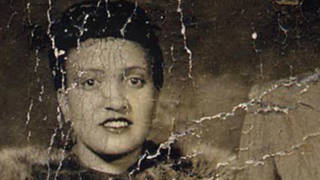
Topics
Guests
- Dr. Michael KlagDean of the Johns Hopkins Bloomberg School of Public Health.
- Dr. Caroline SnyderProfessor Emeritus at the Rochester Institute of Technology.
She recently published a peer-reviewed paper dealing with the politics and science of sludge disposal.
Lawmakers and the NAACP last month called for an investigation into reports that federally funded scientific experiments in 2000 spread sewage sludge on the yards in poor black neighborhoods to test if it could fight lead poisoning in children. The calls came after the Associated Press ran a story on the issue. We host a debate between Dr. Michael Klag, Dean of the Johns Hopkins Bloomberg School of Public Health, and Dr. Caroline Snyder, Professor Emeritus at the Rochester Institute of Technology. [includes rush transcript]
Transcript
JUAN GONZALEZ: Lawmakers and the NAACP last month called for an investigation into reports that federally funded scientific experiments in 2000 spread sewage sludge on the yards in poor black neighborhoods to test if it could fight lead poisoning in children. The calls came after the Associated Press ran a story on the issue. The researchers say the experiment successfully reduced the amount of lead in the soil, but some scientists question the findings, as well as the choice of neighborhood and lack of transparency with the residents.
AMY GOODMAN: When the article came out, we spoke with John Heilprin, the AP reporter who broke the story. I asked him who the families were that accepted the sludge be spread in their yards.
JOHN HEILPRIN: Well, one of the problems is we don’t know exactly who they are. No one will identify them. They were all families from these poor, low-income neighborhoods, black neighborhoods in Baltimore in so-called empowerment zones. And all of them agreed to take on—to have this Class A fertilizer tilled into their lawns. These were basically bald dirt lawns with high levels of lead contamination. And the Class A sludge fertilizer was tilled into the lawn to create grass cover, and on the theory that if the children ate the dirt, they would be better protected from the lead contamination, because the sludge would mix with the lead in the soil and make that pass safely through the body. That was the researchers’ theory.
AMY GOODMAN: But John, these families were given a financial incentive to accept this sludge on their lawn.
JOHN HEILPRIN: They were. They were given food coupons, free lawns, free doormats. We didn’t put that in the story. And they were essentially told that this was commercial-grade fertilizer, that it was safe, as you reported, and that they would be better off, that they would be better off using this fertilizer than before.
The thing that I found interesting was that this government-sponsored research essentially operates on the premise that this fertilizer is safe enough and good enough to eat, even though the researchers say that the fertilizer was not fed directly to the children. The premise of the research is that if they eat it, they will be better off.
AMY GOODMAN: John Heilprin, you quote a scientist, Dr. McBride, saying that it’s actually not safe for the kids. There’s a real question here. The soil chemist from the Cornell Waste Management Institute said, when eaten, “it’s not at all clear that the sludge binding the lead will be preserved in the acidity of the stomach. Actually thinking about a child ingesting this, there’s a very good chance that it’s not safe.”
JOHN HEILPRIN: Well, that’s right. There’s—first of all, the EPA’s inspector general has twice said that there’s no way that the EPA can assure the public that sludge is safe. This theory that the phosphate and iron can bind to the lead might work in the soil; however, as Murray McBride said, the stomach acids will probably break down—will break out the lead from the soil. In fact, in 2003, another scientist, an EPA microbiologist, David Lewis, had also come to the same conclusion. He was working within the EPA’s Office of Research and Development, and he used to call this theory “sludge magic.”
AMY GOODMAN: John Heilprin, speaking on Democracy Now! last month. His report implicated researchers and funders at Johns Hopkins University, the Kennedy Krieger Institute, the Environmental Protection Agency and others.
After we ran the segment, Johns Hopkins contacted us, demanded we retract the story. We’ve invited them on the program today to tell their side of the story. Dr. Michael Klag is the dean of the Johns Hopkins Bloomberg School of Public Health. He joins us in Baltimore. And we’re joined on the telephone by Dr. Caroline Snyder, professor emeritus at the Rochester Institute of Technology. She recently published a peer-reviewed paper dealing with the politics and science of sludge disposal. We welcome you both to Democracy Now!
Let’s begin with Dr. Michael Klag. Can you talk about the allegations of John Heilprin, the AP reporter?
DR. MICHAEL KLAG: Certainly, Amy. And we really appreciate that you are having us on the show. This article was filled with inaccuracies and misrepresentations, which creates the wrong impression that children were targeted for some experimental toxic treatment. Nothing could be further from the truth. In fact, if you read that article and look at it, they have a picture of Type B biosolids, which looks like human waste matter being held in a farmer’s hand while it’s spread on the field. That’s just one of the things that creates the wrong impression, that this is what was done in this study.
Here’s what was done. What was done is, people went to a composting facility and got compost that you or I could buy in a store that’s approved by the federal government for unlimited use and is approved by the Maryland Department of the Environment for unlimited use, and they have much more stringent guidelines than the federal government. That was put on lawns to grow grass. The interview you just ran creates the impression that we were feeding fertilizer and human waste to children. The idea was that if you reduce the dust in the yards, because the yards, as you said, had no grass, then that dust would not be tracked into the house, where it becomes part of the house dust and toddlers and small infants can ingest it by crawling around. So there are many inaccuracies in this story. That’s one.
But let me — I’m not sure how long you want me to go on — but he quotes David Lewis on this subject. And let me just read some quotes from David Lewis. “Almost no bacteria survive in Class A sludge, which is heated more and treated with additional chemicals.” In other articles, Mr. Lewis says, “There’s a simple cure for the sludge problem: don’t use Type B; use Type A.” This article confuses Type A and Type B biosolids. Type A is where sewage sludge is taken, it’s heated, pasteurized, just like milk is pasteurized, to kill pathogens, mixed with wood chips and wood dust, and left to compost for several months. It’s a commercially available product that’s used widely. The notion that it was somehow used only and targeted at poor families is just wrong. It’s used on the White House lawn. It’s used on the congressional golf course. It’s used at Camden Yards, our local golf course — or our local Orioles park. It’s used very widely.
AMY GOODMAN: Is this why President Bush has said he’s not going to play golf anymore?
DR. MICHAEL KLAG: Yeah, I don’t want to get into the politics of the effects of sludge. So there is a big debate, which I know we’re going to hear about, about the use of sludge. But to suggest that this was anything other than a study that used store-available, store-bought compost to grow lawns is just egregious.
JUAN GONZALEZ: And the issues that he raised about the transparency and the explanation to the people who were receiving this material on their lawns or in yards?
DR. MICHAEL KLAG: Right. So, the transparency — we are prevented by federal law from revealing the names of these people. When we got permission to use their yards, we signed a document with them that we promised not to reveal who they are. In every radio show I’ve been on and in interviews with the press, I’ve indicated people are free to identify themselves, to say that they participated in this study to grow grass. But I can’t reveal their names. And so far, nobody has done that. But it’s their choice, not mine, to reveal. And the reporter was told this, and to portray that as somehow a lack of transparency or underhandedness is just wrong.
AMY GOODMAN: Let’s bring Dr. Caroline Snyder into this discussion, professor emeritus at the Rochester Institute of Technology. Your response?
DR. CAROLINE SNYDER: Well, Dr. Klag has made an awful lot of misleading statements already in the first ten minutes of this show. I think it’s very important to point out that just because something is commercially available and just because it’s called “compost,” and just because it’s spread on the White House lawn, which is a media event for a PR gimmick, does not mean that this material is safe. Class A sludge should not have been put on contaminated — soil that was already highly contaminated with lead. It’s simply exposed families to additional, additional risks.
This so-called compost, which really is a polluted material — I think a lot of people don’t realize what sludge is. It is all the toxic and harmful stuff that’s taken out of wastewater, so the wastewater can be returned to the environment. It’s all that material that’s concentrated in sludge. The federal Clean Water Act defines sludge as a pollutant. And you shouldn’t put pollutants on soil, and you certainly shouldn’t be putting it on in residential areas that are already polluted by lead. And so, these risks — we believe that this whole experiment actually put the families and the children at additional risk. Why on earth did they not use clean compost, unpolluted compost, as a vehicle to deliver, you know, iron and phosphate, which, to some extent, might help with the lead abatement, although even there are some scientific questions? So there are some legal, there’s some scientific, there’s some ethical questions about this whole, whole experiment.
I just want to also say that the AP coverage was fair. It was totally accurate. And in fact, AP hasn’t even begun — hasn’t even begun to report on the serious health and environmental problems that have been linked to the land application of sewage sludge. There is no scientific evidence that this practice is safe. There’s a lot of deception. There’s a lot of cover-up of incidents.
David Lewis is one of the victims. He was courageous enough to get into this. Very few scientists go into this, because they realize that being a whistleblower in this particular issue is a very risky practice. And he lost his job by actually doing research and publishing the link between human health and the use of sludge.
So the statement by Dr. Klag that this is safe and that it was germ-free is a totally false statement. The way sludge is treated to reduce pathogens does not kill all the germs. So, the families were misinformed about that, and they were misinformed by being told it was risk-free. We have incidences where actually people, landscapers who have used this material and touched it, have gotten skin infections and respiratory problems.
We have incidences that the most famous of all sludge compost, namely Milorganite, which is more famous than Orgro, had salmonella grown — re-grown in it, and when it was shipped to Canada, Canadians — it did not pass the Canadian fertilizers rules, and it had to be shipped back to the United States. We have another incident with Milorganite, or with the plant that produces the sludge that goes into Milorganite in Milwaukee, Wisconsin. The Class A sludge was spread on twenty-four playing fields of children, where children play, and after it was spread, they discovered it had such high levels of cancer-causing PCBs that it had turned these playgrounds into Superfund sites. So they had to actually scrape all that stuff up again, truck it away to another state, where it was put into hazardous waste landfills.
JUAN GONZALEZ: I’d like to bring back Dr. Michael Klag into the discussion. A couple of points that Dr. Caroline Snyder raised, Dr. Klag, one about the issue of the difference between this sludge and what she calls “clean compost” and why you didn’t use that; and also the issue of whether the processes to clean Class A sludge really get rid of all of the contaminants that exist in it.
DR. MICHAEL KLAG: Well, I’m not an environmental expert. My point is that this study was done eight years ago using the best information available at that time, using a product that’s approved by the federal and state governments for unrestricted use and that is widely used.
DR. CAROLINE SNYDER: Yeah, I’d like to —-
DR. MICHAEL KLAG: It wasn’t the product that was shown in the picture in that article, which is Type B sludge and which there has been much concern about. So what I want to talk about is that this article had misrepresentations about the study and the way it was done and created innuendos about transparency and other things that just aren’t true.
DR. CAROLINE SNYDER: Well, could I make a statement about that? I don’t think it’s a very good idea to base opinions on pictures, but I am going to do that, too. I’ve looked very carefully at the Farfel article. First of all, the soil that was churned up by rototillers was not bare, blowing around; it was compacted and it was held together by plants. So now the researchers come with high-power rototillers and start tilling this lead-contaminated -— and it was highly contaminated, 2,500 parts per million of lead — they start tilling this up right by the basement windows in the middle of summer, tilling it up, loosening up all the soil that had been compacted. Then they add the sludge compost. Then they till it up for a second time.
And I think this whole process has actually exposed the children of the families to additional — to higher risks than if they had perhaps left it alone. There was no need to do this experiment in the front yards of residential neighborhoods. It could have been done on an empty lot somewhere in the city. To do this — and they didn’t fence it in. Did they tell the families to keep their windows closed in the middle of summer, where there’s no air conditioning? Did they tell them there was no fence? So pets could play in it, children could play in it. They could track this stuff down. They’re not now only exposed to ingestion by accidentally eating the soil; they are now being exposed through inhalation and dermal contact, as well. So we feel not only that the sludge itself presented — sludge compost presented an additional risk, but the actual process, the actual process of putting this material into leaded soil, was additional — an additional exposure to lead.
If the Krieger Institute is really interested, if society is really interested in protecting children from lead poisoning, they should move families out of those houses, clean up the houses, cover up the soil, and not have children in this rich country be exposed to high levels of lead and then, in addition, to the risks that are associated with sludge.
AMY GOODMAN: Dr. Michael Klag, your response?
DR. MICHAEL KLAG: Certainly. Well, I don’t know if the doctor has ever been to Baltimore, but in 2000, we were suffering one of the worst epidemics in the world of lead poisoning in children. Kennedy Krieger Institute was seeing over a thousand cases a year of lead poisoning. As you know, lead poisoning causes growth retardation, decreased cognitive status, decreased IQ, behavioral problems, and is a predictor of getting in trouble with the law many years later. And it’s irreversible once it occurs.
So the people at Kennedy Krieger were treating all these children from the same neighborhoods year after year, neighborhoods with very high levels of lead in the homes, most of which was from paint, but some which is from soil exposure. They were trying to find ways to prevent lead poisoning before it occurred. This was one of the studies in which they did that.
It would be ideal to knock all those homes down, to abate entirely the neighborhood, but 95 percent of the housing stock was built before 1978, when lead was removed from paint. The kinds of solutions that are being suggested aren’t practical. So the investigators were looking for a way to do this. It had been shown around in industrial settings, around lead smelters, that putting compost in the soil reduced bio-available lead. It had been shown in the laboratory in Baltimore that if you took the soil from yards to the laboratory, treated it, grew grass, you reduce bio-available lead. So, we knew this had been done.
There had been thought of doing it in a vacant lot, as the doctor suggests. But the problem with that approach is that the grass needed to be maintained. The idea here is that if you have grass growing, you don’t track the dust and dirt into the house. So it needed to be maintained. And also, because of the neighborhoods in which this was done, it was not safe for the workers to go into the vacant lots.
So, the other thing I should mention is, this compost was picked in part because the community had been using it in community gardens as part of a greening project. So this was something that had been used by the community for many years. That’s one of the reasons the product was picked.
DR. CAROLINE SNYDER: Well, just because it’s used does not mean it’s safe. Let me very quickly tell you what legally is allowed to be in sludge compost: forty-one parts per million of arsenic, thirty-nine parts per million of cadmium, 300 parts per million of lead. Now, what on earth — what sense does it make to put a polluted compost in these already polluted yards that already contains lead? Why use this particular controversial material? It’s very controversial to use, and there’s very little difference really between Class A sludge and Class B sludge. Class A sludge contains virtually the same amounts, legally, of toxic metals, toxic organics — tens of thousands. We only regulate a handful of these. There was absolutely no excuse for using sludge as the vehicle to deliver phosphate and iron.
AMY GOODMAN: We only have a minute to go. Final comments, first from Dr. Michael Klag.
DR. MICHAEL KLAG: Well, I would say that the Maryland requirements are much stricter than the federal requirements just quoted. This was a study in nine yards of buying a — using a store-bought compost to grow grass, and it was one in an incredibly high-risk neighborhood that helped these families by providing lawns. The article, the AP article, is inaccurate in many ways about this study.
DR. CAROLINE SNYDER: I think your comments are inaccurate, very inaccurate, by claiming — by telling the families that there were no germs in it, that it was safe, that it would make their yards safe. What is going to prevent them from growing vegetables there? And think of the risks then.
AMY GOODMAN: We’re going to have to leave it there, and I thank you both for being with us, but we’ll continue to follow the story. Dr. Caroline Snyder, professor emeritus at the Rochester Institute of Technology, and Dr. Michael Klag, dean of the Johns Hopkins Bloomberg School of Public Health.
DR. CAROLINE SNYDER: Thank you very much.
AMY GOODMAN: Thank you both for being with us.
DR. MICHAEL KLAG: Thank you.













Media Options